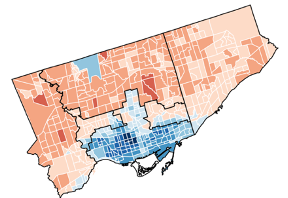line

A central question in the Urban Genome Project concerns the processes by which features of urban life reproduce themselves over time according to characteristic spatial patterns. One of the surprisingly enduring features of many cities is their characteristic political order: political alliances and oppositions expressed in their geographies.
Our recently published study, “The spatial articulation of urban political cleavages,” examines the bases of this recurrent order, using Toronto, London (UK), and Chicago as case studies. We investigate how a certain activity — mayoral voting — varies depending on the concentration of groups, the built environment, and its spatial location. In the context of our general theory of urban evolution, this can be viewed as an effort to identify the extent to which the recurrent patterns of political activity in these cities derive from variations in their underlying genomes and the emergence of ecological niches in which those activities tend to thrive.
The abstract is below, and a more detailed summary with key figures and results may be found here.
Synthesizing and extending multiple literatures, this article develops a new approach for exploring the spatial articulation of urban political cleavages. We pursue three questions: (1) To what extent does electoral conflict materialize between rather than within neighborhoods? (2) How salient are group, place, and location in defining urban cleavages? (3) How do these sources inflect one another? To answer these questions, the article analyzes a novel longitudinal database of neighborhood-scale mayoral voting in Chicago, Toronto, and London. We find strong evidence of spatially articulated cleavages: in each city, voting patterns are equally or more geographically concentrated than the non-White population, income, and poverty. While group-based interests define Chicago’s cleavage structure, place and location are paramount in Toronto and London. We conclude by proposing a research agenda for investigating the spatiality of urban politics and advancing a preliminary typology of urban political cleavages and the conditions under which they may arise.


Leave a Reply
You must be logged in to post a comment.